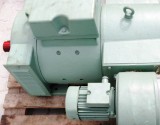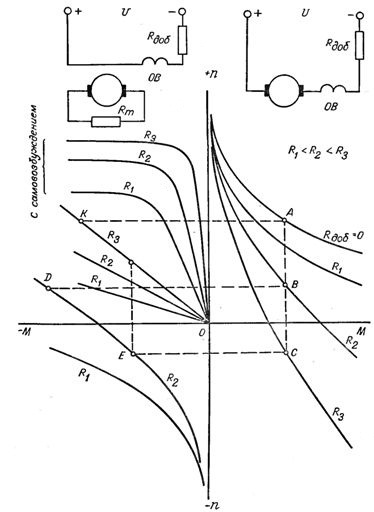Sequential excitation motor braking modes
 Series-excited DC electric motors in electric drives operate in both driving and braking modes. In contrast to a parallel excitation motor, generator mode with energy return to the network for series excitation motors is inapplicable, since the transition to this mode, as seen from the mechanical characteristics (Fig. 1), would require an unacceptably high rotational speed. The main one, the easiest to implement, is an opposite braking mode.
Series-excited DC electric motors in electric drives operate in both driving and braking modes. In contrast to a parallel excitation motor, generator mode with energy return to the network for series excitation motors is inapplicable, since the transition to this mode, as seen from the mechanical characteristics (Fig. 1), would require an unacceptably high rotational speed. The main one, the easiest to implement, is an opposite braking mode.
In machine drives with potential static moments (for example, lifting winches), the transfer from the motor mode to the opposite is carried out by introducing additional resistance in the armature circuit (point A). The torque of the motor decreases, and under the action of the static moment created by the load, the motor will begin to rotate in the opposite direction to the action of its moment. The load will be lowered (point C).
For braking electric machines with reactive (no potential energy reserve) static torque, reversing (reverse) winding switching is used. All that has been said above in connection with the representation of the characteristics in this and other modes of the independently excited motor applies equally to the series-excited motor.

Rice. 1. Connection diagrams and mechanical characteristics of DC motor with series excitation
Electrodynamic braking mode A series-excitation motor is implemented in two ways: self-excitation and self-excitation. With independent excitation, the field winding is connected to the grid through the limiting resistor, and the armature disconnected from the grid is connected to the braking resistor. In this case, the magnetic flux will be constant, and the operating mode and mechanical characteristics of the motor will correspond to a similar electrodynamic braking of a parallel excitation motor.
Sometimes in dynamic braking, self-excitation is used, that is, the armature, disconnected from the network, closes to the braking resistance, forcing the motor to operate in the mode of a self-excited generator. In this case, it is necessary to switch the ends of the armature or excitation windings, then the generator mode current will increase the flux of residual magnetism, otherwise self-excitation will not occur.
At low revs, the engine also does not excite. Starting with a certain speed value, the self-excitation process proceeds very quickly, which causes a sharp increase in the braking torque; as a result, the mechanical part of the drive is subjected to shock.
Such phenomena are usually undesirable, which is why self-excitation is used in the event of an emergency stop. The self-excitation mode does not require powering the coils from the network.
